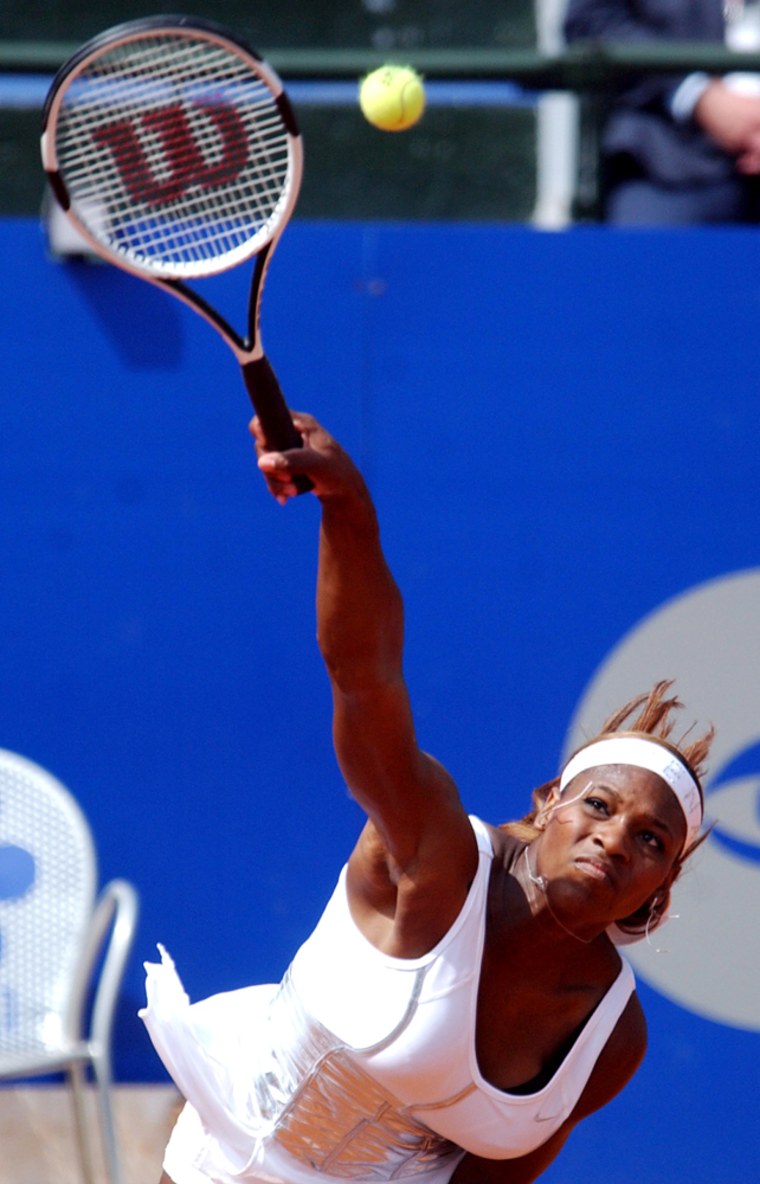For so long Venus and Serena Williams boasted it all at Wimbledon: power, athleticism, confidence and charisma. And each time they strode onto the grass courts of the All England Lawn Tennis & Croquet Club, they exuded an air of invincibility.
The events of the past 12 months have added an unexpected quality to the sisters' portfolio: vulnerability.
After extended layoffs for injury (knee surgery in Serena's case; strained abdominal muscles on Venus's part), they returned to the game earlier this year but have hardly dominated, particularly at the recent French Open, where both sisters struggled with form en route to quarterfinal collapses.
While tennis insiders insist that Venus and Serena remain the best in the women's game, their relatively early ousters at Roland Garros prove that they can't simply roll out of bed or jet in from Cannes and expect to collect their customary hardware. And that realization has supplied Wimbledon, which gets under way Monday, with its most compelling story line: Are the Williams sisters ready -- physically, mentally and emotionally -- to reclaim their place atop the women's game and reclaim the tournament that has been theirs four years running?
"The world loves winners, celebrity and fashion, and maybe more than any other athletes in the world Venus and Serena deliver on all three," said Arlen Kantarian, chief executive of the U.S. Open. "They are always an intriguing story. But interestingly enough, they are now in what I'd call the more enviable position of a comeback story. Fans always love comeback stories. Will they come back? Will they get back on top?"
Wimbledon officials hardly regard the sisters as underdogs, overlooking their world rankings (Venus is eighth; Serena, 10th) to seed defending champion Serena No. 1 and Venus No. 3. That sets up the possibility of an all-Williams Wimbledon final for the third consecutive year.
It was here, on the lush grass courts of Wimbledon, that the sisters were last healthy, with Serena defeating Venus in the final to claim her second consecutive Wimbledon title. (Venus won the tournament in 2000 and 2001.) It capped an incredible run in which the sisters won eight of 11 Grand Slam tournaments.
While some fans muttered that the game had become a snooze-fest pitting Williams against Williams, players and commentators credited the sisters' power and expertise with raising the level of play all around.
"They brought so much excitement and drama and great tennis when they were healthy," said former player Mary Joe Fernandez, now an ESPN analyst. "They forced everyone to pick it up and do more."
Says Raquel Giscafre, a forming Argentine touring pro and tournament director of San Diego's Acura Classic: "Before the Williams there were power players: Jennifer Capriati, Monica Seles, Lindsay Davenport. When the Williamses came to the tour they added more power, so everybody had to step up their power. They came in with great serves and forehands and backhands. They changed the women's game and raised the bar."
But injury and fatigue took their toll.
Serena underwent surgery on her left knee Aug. 1, and Venus idled six months with an abdominal injury. Their comebacks were slowed further by the lure of outside interests. Serena pursued a budding acting career, while Venus nurtured her fledgling design business.
In one sense, their hiatus gave the women's game more depth. It coincided with the emergence of Belgian stars Justine Henin-Hardenne and Kim Clijsters. With the Belgians ailing in recent months, a cadre of young Russians has taken center stage. French Open champion Anastasia Myskina, who is seeded No. 2 at Wimbledon, is one of 10 Russian women among the top 50.
But in another sense, the Williamses' hiatus has hurt the game, draining it of the buzz and excitement they created with their powerful serves, rocket-like returns, stylish outfits and fresh personas.
Said Kantarian, "Let's not forget that the tidal wave of interest in women's tennis three years ago started with Venus Williams, and Serena added to it."
Venus, who turned 24 last week, hasn't won a major title since 2001. Serena, 22, hasn't advanced to a major final since Wimbledon last year.
That doesn't mean their peers take them lightly, however.
"They are definitely the two top players in the world," said Russian prodigy Maria Sharapova in a conference call last week. "Even though they had injuries, they've come back and they're very strong. You can never consider them out of the game; they're always going to be a threat."
Getting the Williamses back in top form would be a boon not only for the women's game, but also for the sport in general.
Giscafre has run the Acura Classic during years in which both sisters competed (Venus won it three years in a row) and last year, when injury sidelined both. Not surprisingly, she prefers having both in the draw.
"They are a vital ingredient to a tournament in every aspect," Giscafre said. "The ticket sales go up, sponsorship sales go up, media interest goes up. There is more awareness of charity functions at the tournament, so the tournament benefits and the community benefits. Tennis benefits, too, because more kids and more adults start playing tennis."
While the four Grand Slams (Australian, French, Wimbledon, and U.S. Open) are less vulnerable to the withdrawals of marquee players, there was no question that last year's U.S. Open wasn't as electric without a Williams in the draw.
"There is an impact," Kantarian says. "Golf has Tiger, basketball has the Lakers and tennis has the Williams sisters."
